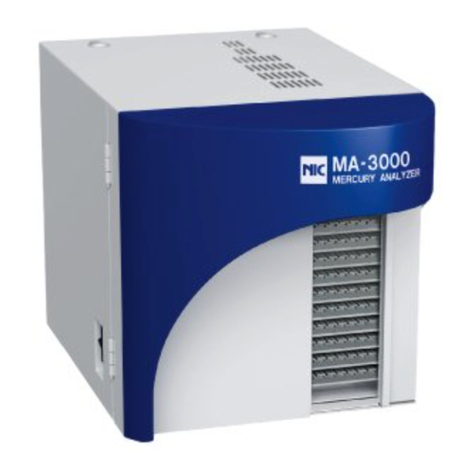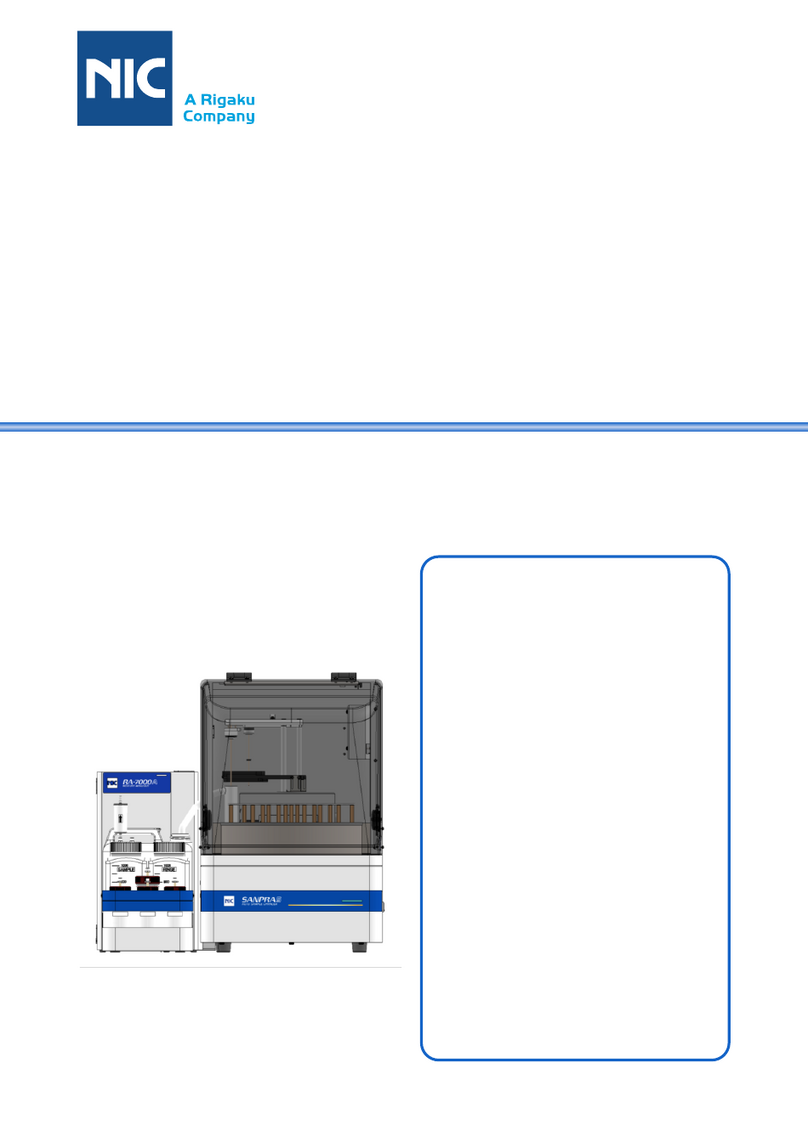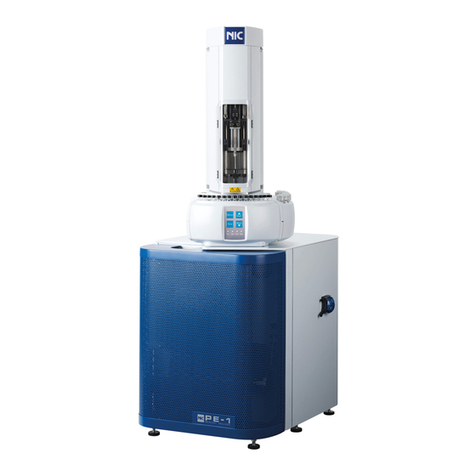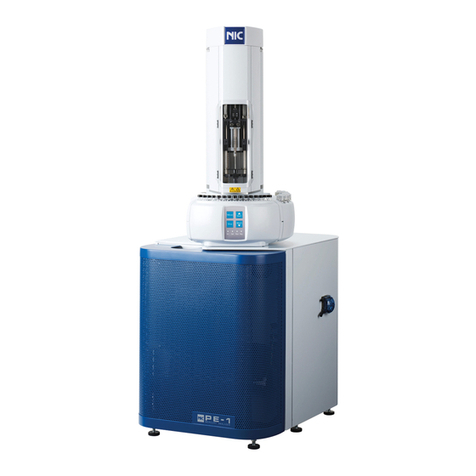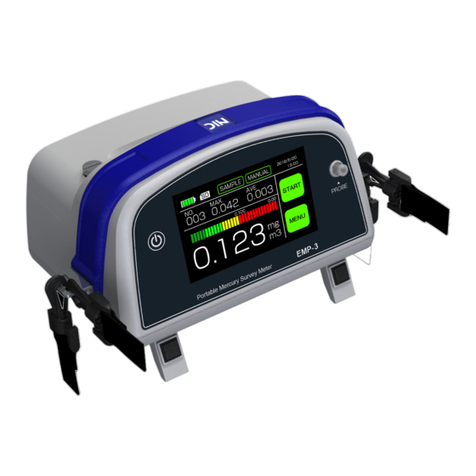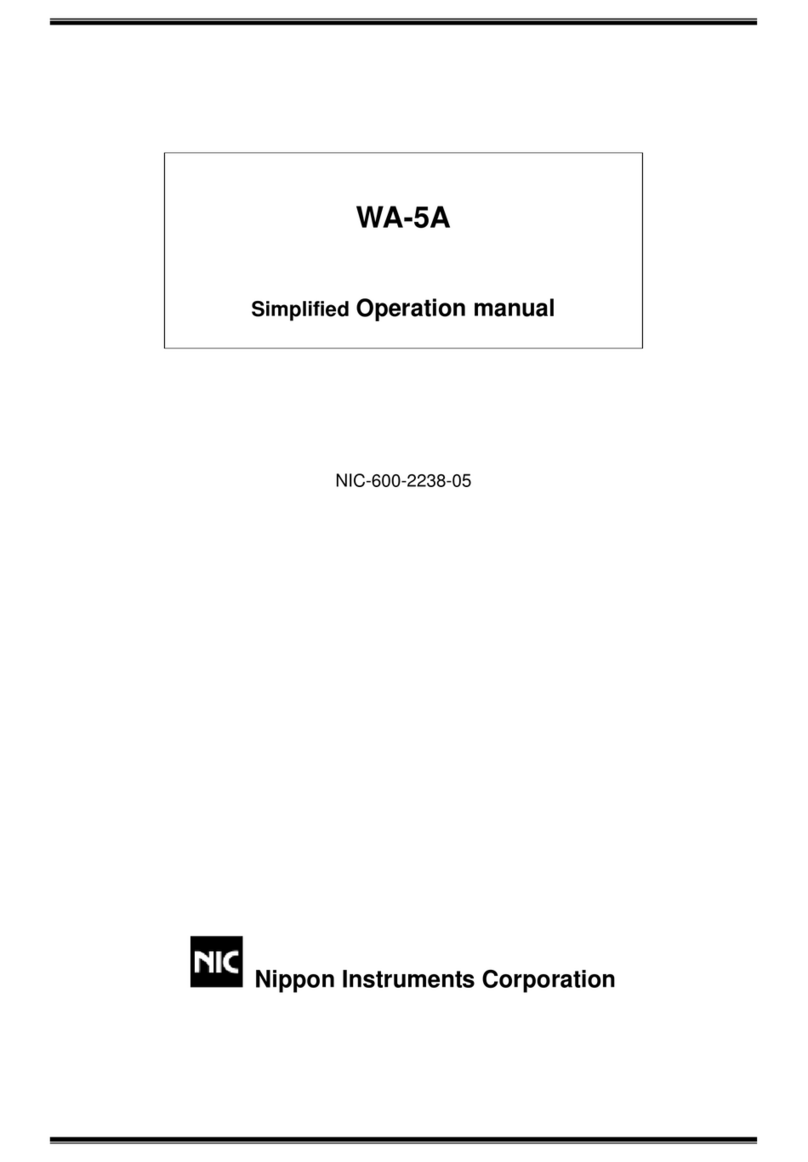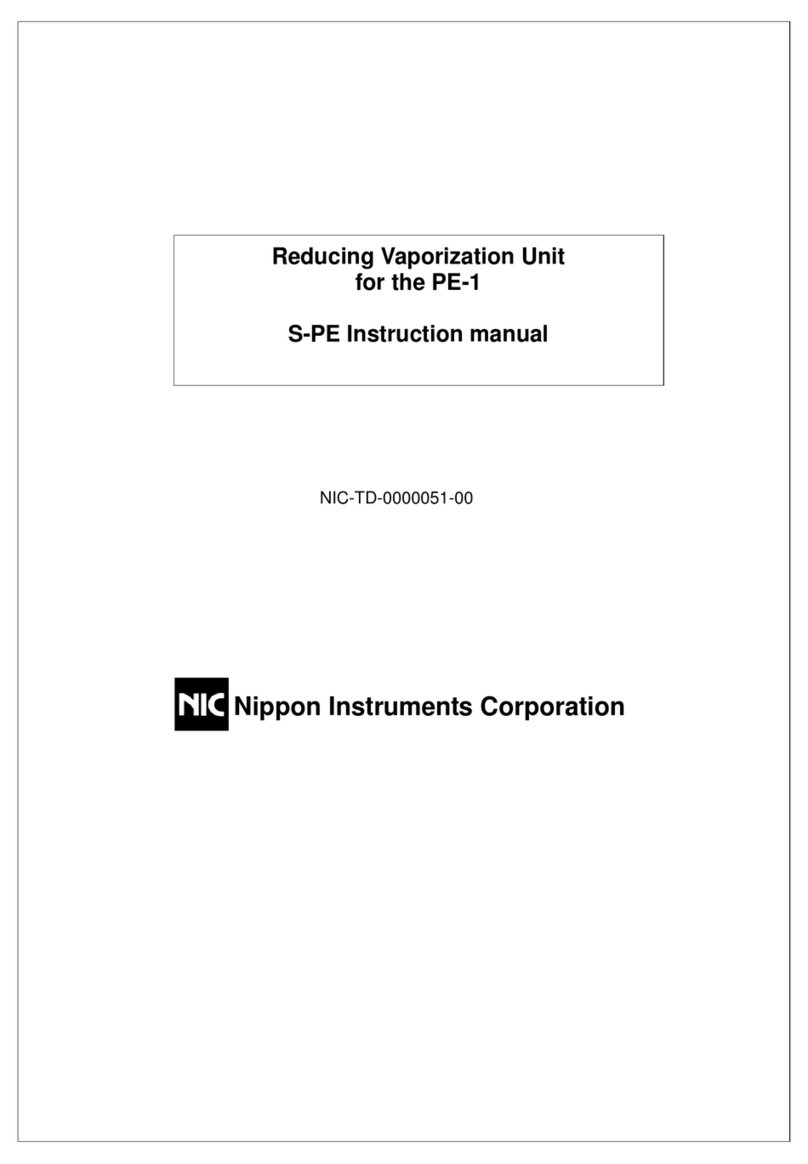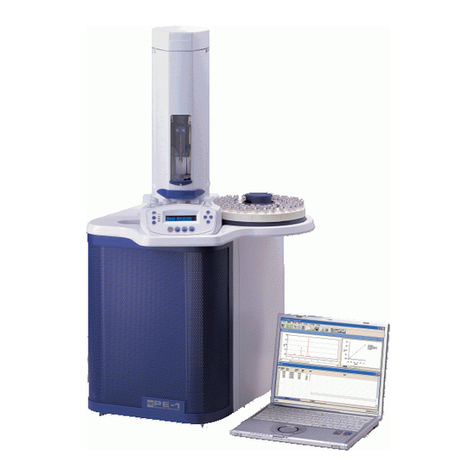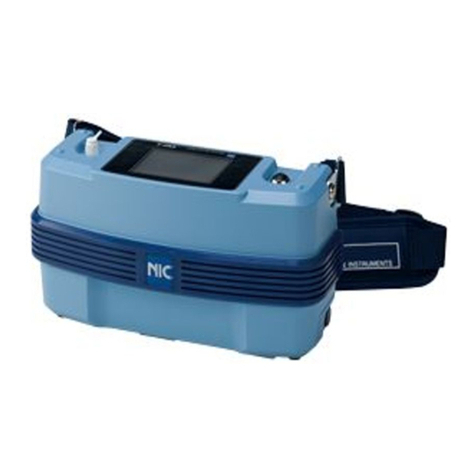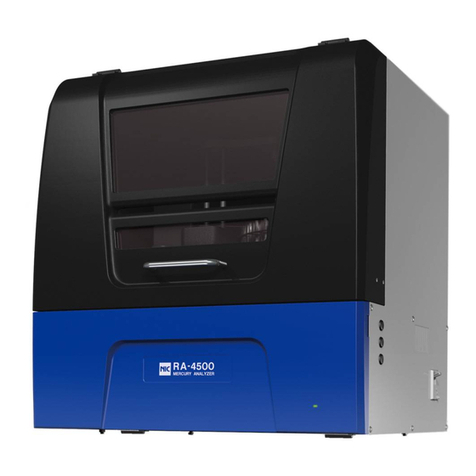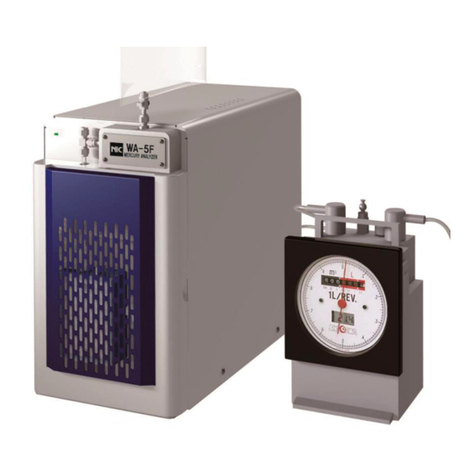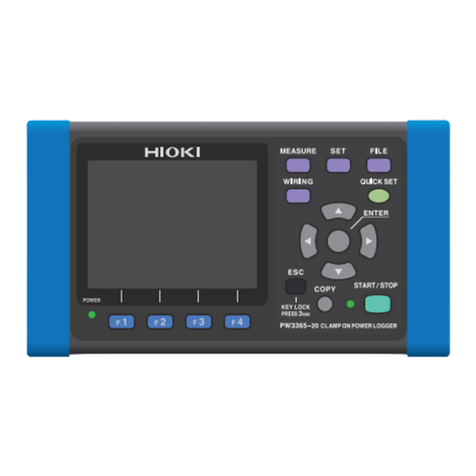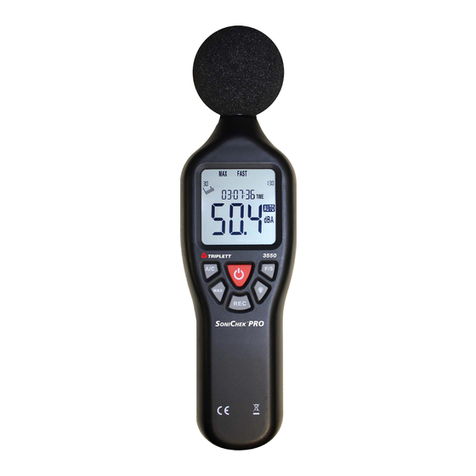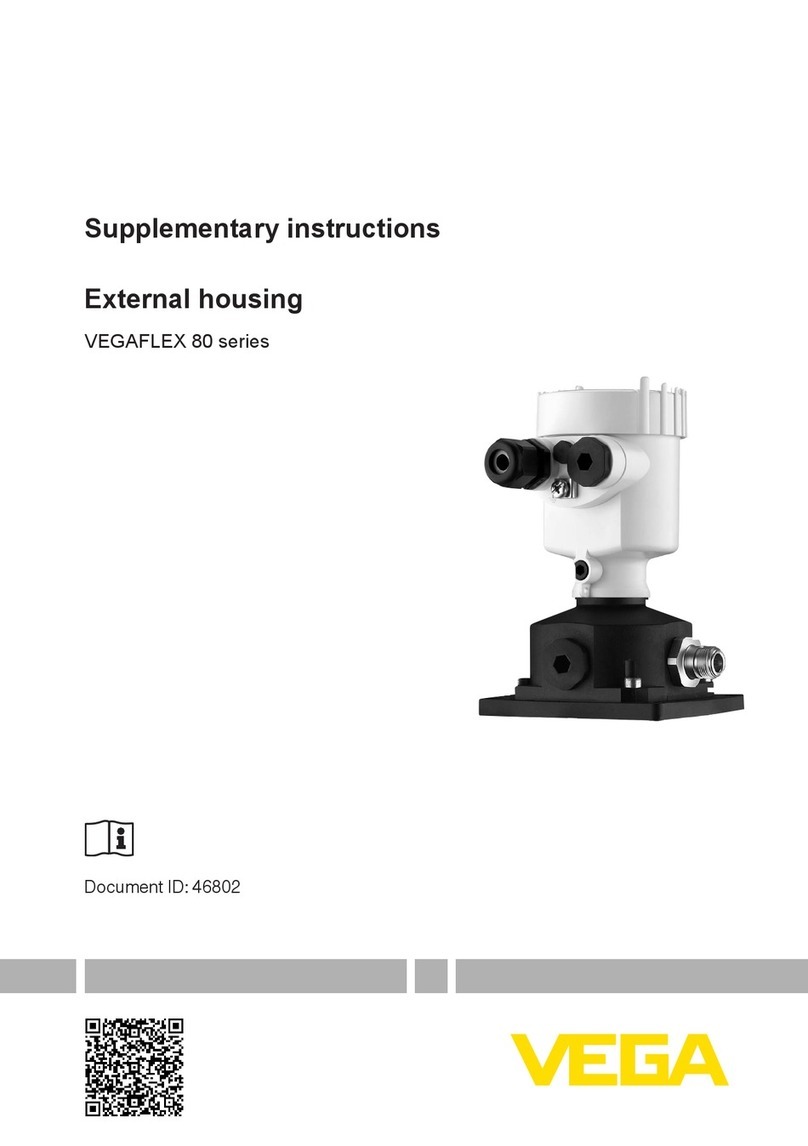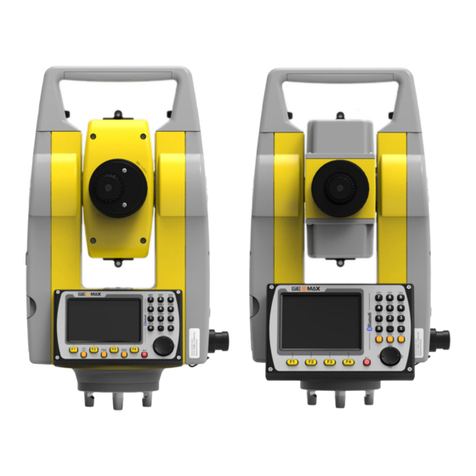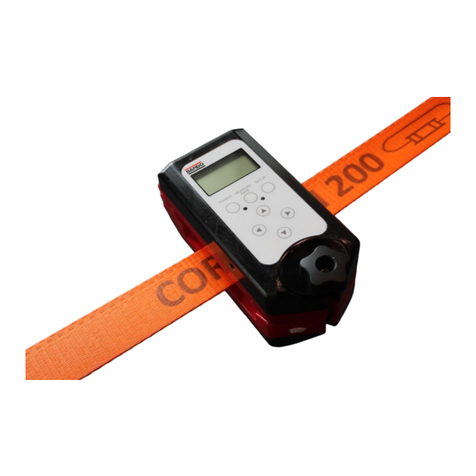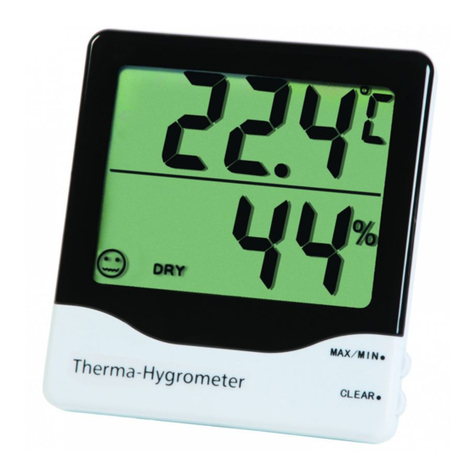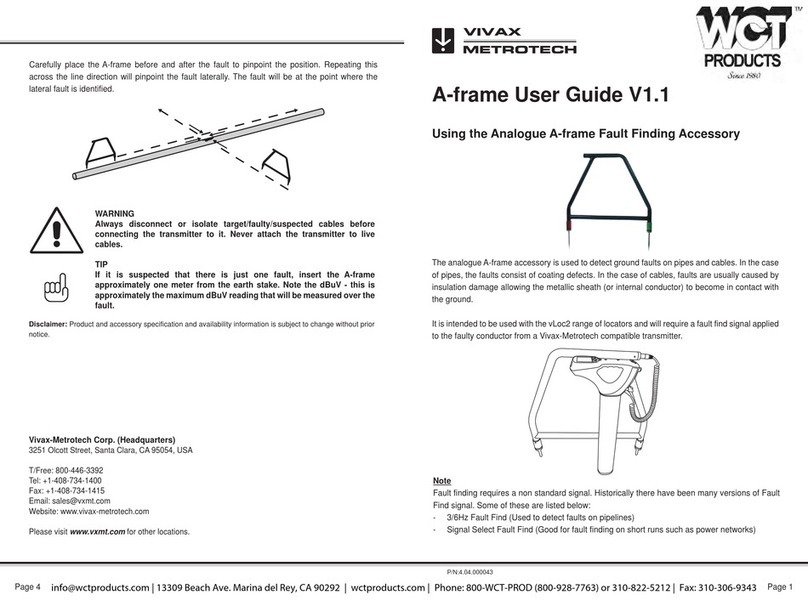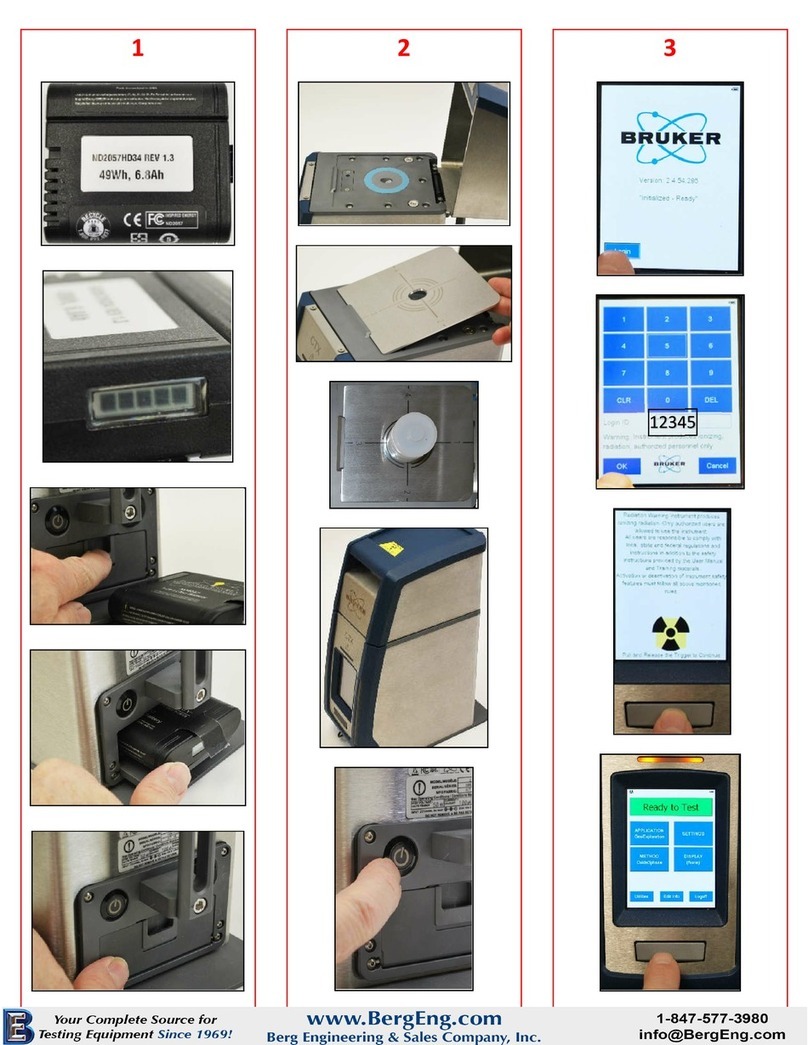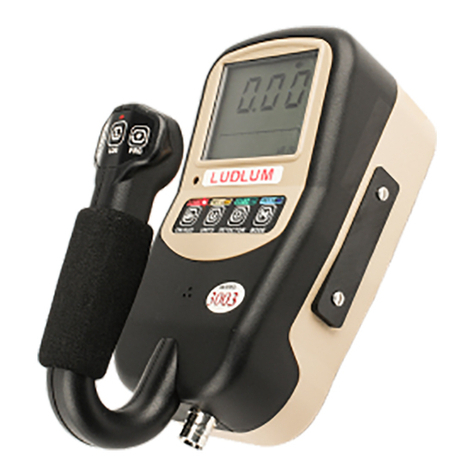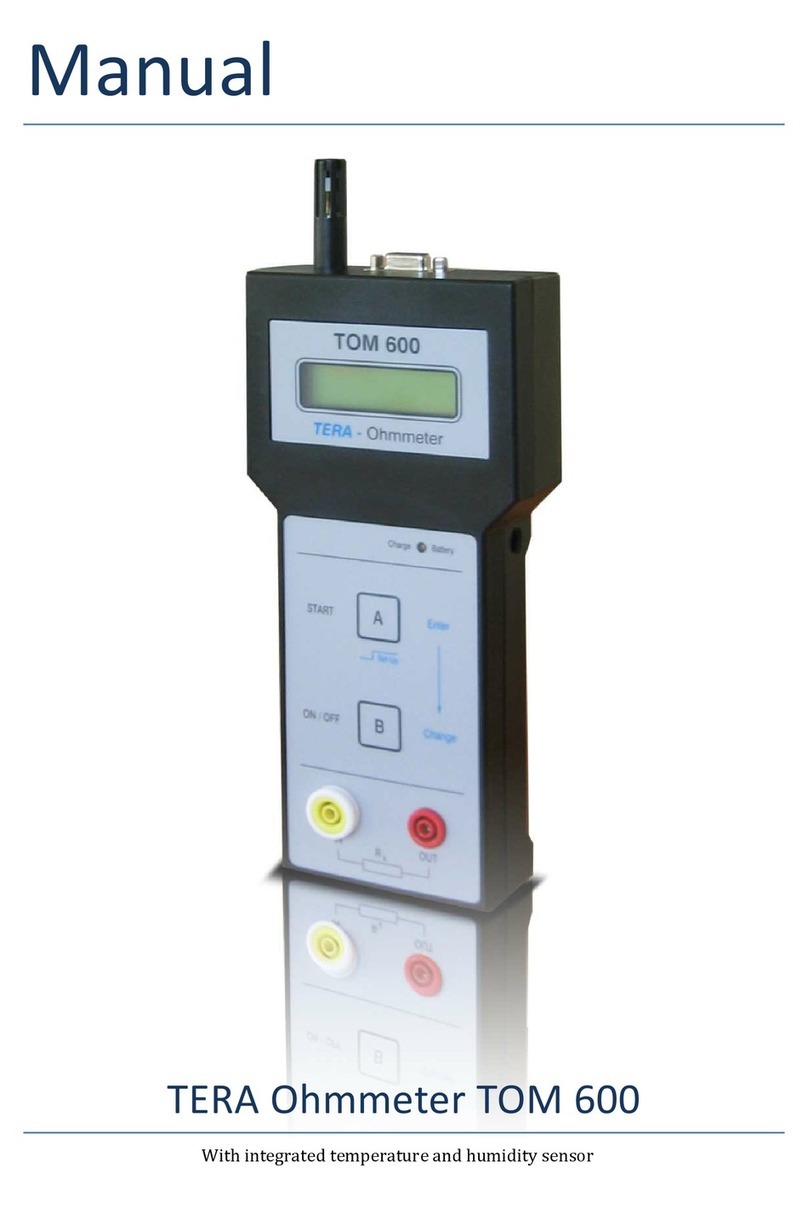Nic Mercury/RA-4300A User manual

Reducing Vaporization Mercury Analyzer
Mercury/RA-4300A
Instruction Manual
NIC-600-2224-05
Nippon Instruments Corporation

NIC-600-2224-05
MERCURY/RA-4300A
Mercury/RA-4300A
Instruction Manual
Table of Contents
1. INTRODUCTION............................................................................................................. 1
1.1. Safety precautions................................................................................................... 1
1.1.1. Meaning of safety alert symbols....................................................................... 1
1.1.2. Installation precautions..................................................................................... 1
1.1.3. Handling precautions........................................................................................ 1
2. OVERVIEW OF THE INSTRUMENT.............................................................................. 2
2.1. Measurement principle............................................................................................. 3
2.2. Part names and functions........................................................................................ 4
2.2.1. Front.................................................................................................................. 4
2.2.2. Left side ............................................................................................................ 5
2.2.3. Right side.......................................................................................................... 6
2.3. Measurement flow.................................................................................................... 7
2.3.1. Purge line.......................................................................................................... 8
2.3.2. Measuring line .................................................................................................. 9
2.3.3. Blowing line..................................................................................................... 10
2.4. Operation sequence................................................................................................11
3. INSTALLATION AND CONNECTIONS........................................................................ 12
3.1. Installation of the instrument.................................................................................. 12
3.2. Installing RA4Win................................................................................................... 13
3.2.1. Installing RA4win............................................................................................ 14
3.2.2. Installing the animation player........................................................................ 15
3.2.3. Making the network settings........................................................................... 16
3.2.4. Setup of IP address (network adapter)........................................................... 16
3.2.5. How to uninstall............................................................................................... 18
4. STARTUP AND ENDING OPERATION ....................................................................... 19
4.1. Startup.................................................................................................................... 19
4.1.1. Starting the RA-4300A.................................................................................... 19
4.1.2. Starting the control software........................................................................... 19
4.1.3. Self-check....................................................................................................... 20
4.1.4. Filling reagents................................................................................................ 20
4.2. Ending operation.................................................................................................... 22
4.2.1. Reagent discharge.......................................................................................... 22
4.2.2. Closing the control software........................................................................... 23
4.2.3. Shutting down the instrument......................................................................... 23
5. PREPARATION OF REAGENTS ................................................................................. 24
5.1. Preparation of reagents ......................................................................................... 24
5.2. Preparation of standard solution............................................................................ 25
6. MEASUREMENT.......................................................................................................... 26
6.1. Setting the Measurement Condition...................................................................... 27
6.2. Setting the table conditions.................................................................................... 27
6.3. Registering the calibration curve information ........................................................ 28
6.4. Registering unknown samples............................................................................... 29

NIC-600-2224-05
MERCURY/RA-4300A
6.5. Setting the samples in place.................................................................................. 30
6.5.1. About tubes..................................................................................................... 30
6.6. Starting a measurement......................................................................................... 30
6.7. Stopping a measurement....................................................................................... 31
6.8. Reviewing a calibration curve................................................................................ 32
6.9. Reviewing the measurement results...................................................................... 33
6.10. Data saving............................................................................................................ 33
6.11. Printing................................................................................................................... 34
7. CONTROL SOFTWARE RA4WIN................................................................................ 35
7.1. Main screens.......................................................................................................... 35
7.1.1. Table window.................................................................................................. 36
7.1.2. Calibration curve (Calib) window.................................................................... 40
7.1.3. Control screen ................................................................................................ 41
7.1.4. Analysis screen............................................................................................... 42
7.2. List of icons and their function............................................................................... 43
7.2.1. Icons ............................................................................................................... 43
7.3. File menu commands............................................................................................. 44
7.3.1. New................................................................................................................. 44
7.3.2. Open............................................................................................................... 45
7.3.3. Save................................................................................................................ 45
7.3.4. Page Setup..................................................................................................... 46
7.3.5. Print Preview................................................................................................... 47
7.3.6. Printing............................................................................................................ 47
7.3.7. Quit.................................................................................................................. 49
7.4. Edit menu commands............................................................................................ 49
7.4.1. Copy................................................................................................................ 49
7.4.2. Cut................................................................................................................... 49
7.4.3. Paste............................................................................................................... 49
7.4.4. Remove........................................................................................................... 49
7.4.5. Insert............................................................................................................... 49
7.4.6. Move............................................................................................................... 49
7.4.7. Save as csv file............................................................................................... 50
7.4.8. Save as jpg file ............................................................................................... 50
7.4.9. Add Data......................................................................................................... 50
7.5. Run menu commands............................................................................................ 51
7.5.1. Turn Tray......................................................................................................... 51
7.5.2. Lift Move ......................................................................................................... 51
7.5.3. Reset............................................................................................................... 51
7.5.4. Start................................................................................................................. 52
7.5.5. Stop................................................................................................................. 52
7.5.6. Emergency...................................................................................................... 52
7.5.7. Measurement Condition ................................................................................. 53
7.5.8. Self-check....................................................................................................... 56
7.5.9. Leak check...................................................................................................... 57
7.5.10. Maintenance................................................................................................... 58
7.6. Table menu commands.......................................................................................... 62
7.6.1. Memo Setup.................................................................................................... 62
7.6.2. Table Conditions............................................................................................. 63
7.6.3. Statistics (S).................................................................................................... 66
7.6.4. Registration of sample name (R).................................................................... 69
7.6.5. Table column initialization (I) .......................................................................... 70
7.7. System menu commands ...................................................................................... 71
7.7.1. Setup of IPAddress(RA4/RA4Win)................................................................ 71
7.7.2. Setup of IPAddress(RA4Win)........................................................................ 72

NIC-600-2224-05
MERCURY/RA-4300A
7.7.3. Setup............................................................................................................... 73
7.7.4. Color Scheme Setup....................................................................................... 75
7.7.5. Firmware Update............................................................................................ 76
7.8. Window menu commands...................................................................................... 78
7.8.1. Screen change (Control Screen).................................................................... 78
7.8.2. Screen change (Analysis Screen).................................................................. 78
7.8.3. Usual and Precision/Management Change.................................................... 78
7.8.4. Screen Arrangement Initialization................................................................... 79
7.8.5. Sequence Log and Error History Labeling..................................................... 79
7.9. Help menu.............................................................................................................. 81
7.9.1. Version information......................................................................................... 81
8. SELF-PRECISION MANAGEMENT............................................................................. 82
9. MAINTENANCE............................................................................................................ 86
9.1. Daily inspection...................................................................................................... 86
9.2. Yearly inspection and replacement parts............................................................... 87
9.3. Error and warning .................................................................................................. 88
9.4. Corrective actions.................................................................................................. 90
9.4.1. Abnormal blank value..................................................................................... 90
9.4.2. Poor sensitivity................................................................................................ 91
9.4.3. Leakage.......................................................................................................... 91
9.5. Replacing the parts................................................................................................ 92
9.5.1. Removing the turntable................................................................................... 92
9.5.2. Replacing the reaction tube............................................................................ 93
9.5.3. Replacing the reagent pump tube.................................................................. 96
9.5.4. Replacing the reagent tube ............................................................................ 97
9.5.5. Replacing the tubes inside the detector......................................................... 99
9.5.6. Replacing the cap and bubbler..................................................................... 100
9.5.7. Replacing the lamp....................................................................................... 102
9.6. Cleaning method.................................................................................................. 103
9.6.1. Cleaning the reagent tube............................................................................ 103
9.6.2. Cleaning the cap, bubbler, light absorption cell, and dehumidifier tube....... 103
10. CALCULATION........................................................................................................... 104
10.1. How to determine a calibration curve .................................................................. 104
10.1.1. Linear equations........................................................................................... 104
10.1.2. Cubic equations............................................................................................ 104
10.2. Standard addition................................................................................................. 106
11 SPECIFICATIONS ...................................................................................................... 107
11.1 Component specifications.................................................................................... 107
11.1.1 Detecting unit................................................................................................ 107
11.1.2 Sample pretreatment & reduction unit.......................................................... 107
11.1.3 Reagent dispensing unit............................................................................... 107
11.1.4 Data processing system ............................................................................... 107
11.2 Installation specifications..................................................................................... 108
11.2.1 Installation environment................................................................................ 108
11.2.2 Power supply specifications ......................................................................... 108
12 CONTACT................................................................................................................... 109

NIC-600-2224-05
1. Introduction
MERCURY/RA-4300A 1
1. Introduction
1.1. Safety precautions
1.1.1. Meaning of safety alert symbols
Warning
Indicates that incorrect handling could result in the death or severe injury
to the operator.
Caution
Indicates that incorrect handling could result in moderate or minor injury
to the operator, or damage to property.
1.1.2. Installation precautions
Warning
•Ensure to connect the protective grounding to prevent electric shock.
1.1.3. Handling precautions
Warning
•Shut OFF the power supply before starting any maintenance. Otherwise, it could
result in electric shock.
•Keep your hands away from the auto sampler during measuring operation, or they
could be caught in a moving part, and thus leading to injury as well as damage to
the instrument.
•When using a reagent, be sure to wear protective equipment and properly ventilate
the work area. Reagents to be used in this instrument contain acutely toxic
substances and corrosive substances.
Caution
•Do not touch any sample bottles or the sample table during and shortly after the
heating operation, or you may suffer burns because of its high temperature. Wait
until they cool down to around the room temperature before proceeding with work.
•Be careful when touching or handling any glass parts because they could have
been damaged during work. Failure to observe this may cause injury.
•Be sure to use the instrument within the specifications, or it may break down.
•If samples may contain BrCl, HCl, or other volatile corrosive agents, the inside of
the measurement chamber may be corroded.
To minimize this possibility, we highly recommend that an duct fan is added to the
analyzer.
This option is available through Nippon Instruments Corporation and its dealers.

NIC-600-2224-05 2.Overview of the instrument
MERCURY/RA-4300A 2
2. Overview of the instrument
The Mercury/RA-4300A is a fully automatic mercury analyzer which carries out the
wet decomposition of samples such as drinking water and soil extracts, and then
measures its mercury content utilizing cold vapor atomic absorption spectroscopy.
It is capable of ultrahigh sensitivity measurement with a small quantity of samples.
Since the system determines an undecomposed sample, even less-experienced
personnel can perform the correct measurement.

NIC-600-2224-05 2.Overview of the instrument
MERCURY/RA-4300A 3
2.1. Measurement principle
The instrument adds sulfuric acid to the sample after pretreatment, the mercury
compounds in the solution are oxidized and broken down into divalent mercury ion
(Hg2+).When it adds a stannous chloride (II) solution to this sample subjected to wet
pretreatment, the divalent mercury ion (Hg2+) is reduced to zero-valent metallic mercury
and turns into mercury gas by bubbling.
Hg2++SnCl2→Hg0↑
After removing the acid mist and water vapor generated by bubbling with the
electronic cooling unit, the instrument measures the absorbance of mercury at 253.7
nm which is the first absorption wavelength.
It measures the known mercury amount, creates a calibration curve, and then
calculates the mercury amount from the absorbance.

NIC-600-2224-05 2.Overview of the instrument
MERCURY/RA-4300A 4
⑤
①
②
③
④
⑫
⑥
⑦
⑧
⑨
⑪
⑬
⑭
⑮
⑩
2.2. Part names and functions
2.2.1. Front
①
Measuring cap
⑨
Optical system
②
Rinse tank
⑩
V3 valve
③
Rinse bottle
⑪
V1 valve
④
Reagent bottle
⑫
Activated carbon case
⑤
Reagent stand
⑬
Turntable
⑥
Mist catcher
⑭
Sample bottle
⑦
Dehumidifier
⑮
Dispensing arm
⑧
Drain tank

NIC-600-2224-05 2.Overview of the instrument
MERCURY/RA-4300A 5
2.2.2. Left side
①
Air pump
⑥
Opening for drawing out the effluent hose
②
Reagent pump P1
⑦
Grommet for (transparent) reaction tube
③
Reagent pump P2
⑧
Connection port for (green) reaction tube
④
Rinse pump P3
⑨
Connection port for (yellow) reaction tube
⑤
Reagent pump P4
⑥
①
②
③
④
⑦
⑧
⑨
⑤

NIC-600-2224-05 2.Overview of the instrument
MERCURY/RA-4300A 6
2.2.3. Right side
①
Connectors to optional units.
⑤
LAN cable port
②
Main switch
⑥
RS-232C port
③
Power connector for duct fan
⑦
Ventilation fan (with filter)
④
Main power connector
⑧
Duct fan(option)
Caution
If samples may contain BrCl, HCl, or other volatile corrosive agents, the inside
of the measurement chamber may be corroded.
To minimize this possibility, we highly recommend that an duct fan is added to
the analyzer.
This option is available through Nippon Instruments Corporation and its
dealers.
⑤
①
②
③
④
⑥
⑦
⑧

NIC-600-2224-05 2.Overview of the instrument
MERCURY/RA-4300A 7
2.3. Measurement flow
The instrument drips a reagent for pretreatment using the reagent pumps P1 to P2.
Carrier gas is introduced into the purge line, measuring line, or blowing line by the
switching V1, V2 and V3. The bubbler is washed in the rinse bottle after measurement.
※Use the P4 when using hydroxylammonium chloride solution.
V1
V3
VS
V2
VR
SnCl2
H2SO4
P2
P3
DW
Effluent bottle
Rinse bottle
P1
Cap
Mercury lamp
Activated carbon case
Sample bottle
Drain tank
Green
Dehumidifier
section
Air pump
Cell
Yellow

NIC-600-2224-05 2.Overview of the instrument
MERCURY/RA-4300A 8
2.3.1. Purge line
Before starting measurement, the instrument replaces the gas in the absorption cell
and measuring line.
The valves V3 and V2 turn ON, and the carrier gas flows through the channel shown
in the figure below.
V1
V3
VS
V2
VR
SnCl2
H2SO4
P2
P3
DW
Effluent bottle
Rinse bottle
P1
Cap
Mercury lamp
Activated carbon case
Sample bottle
Drain tank
Green
Dehumidifier
section
Air pump
Cell
Yellow

NIC-600-2224-05 2.Overview of the instrument
MERCURY/RA-4300A 9
2.3.2. Measuring line
After dripping stannous chloride (II) into the sample, the instrument carries out
bubbling in the sample bottle to gasify mercury, and measures its absorbance in the
cell.
The valves V1, V2 and V3 turn ON, and the carrier gas flows through the channel
shown in the figure below.
* Bubbling does not occur when there is a leak in the line.
V1
V3
VS
V2
VR
SnCl2
H2SO4
P2
P3
DW
P1
Effluent bottle
Rinse bottle
Cap
Mercury lamp
Activated carbon case
Sample bottle
Drain tank
Green
Dehumidifier
section
Air pump
Cell
Yellow

NIC-600-2224-05 2.Overview of the instrument
MERCURY/RA-4300A 10
2.3.3. Blowing line
This line is a channel used to purge chlorine gas after bubbler cleaning in the rinse
bottle. The instrument uses this channel to drip the water accumulated in the
dehumidifier tube, into the drain tank.
The air pump runs with all of the valves V1, V2 and V3 set to OFF, which allows the
carrier gas to flow through the channel shown in the figure below.
V1
V3
VS
V2
VR
SnCl2
H2SO4
P2
P3
DW
P1
Effluent bottle
Rinse bottle
Cap
Mercury lamp
Activated carbon case
Sample bottle
Drain tank
Green
Dehumidifier
section
Air pump
Cell
Yellow

NIC-600-2224-05 2.Overview of the instrument
MERCURY/RA-4300A 11
2.4. Operation sequence
The following operation sequence is ailable.
* Changing the reagent concentration could damage or block a tube.
Reagent dispensing
Sample presence check
Sulfuric acid (1+1) (Normally 0.6 mL)
or 1% hydroxylammonium chloride
solution(Normally 3.0 mL)
10% stannous chloride solution
(Normally 0.3 mL)
Purge (10 sec.)
Repeat the cycle for all samples
Output of measurement results
The sample may be added during measurement.
Bubbler cleaning (Normally 15 sec.)
Preparation of reagent, rinse liquid, and
effluent bottle
POWER ON
Initialization
Filling reagents
Start
Measurement (Normally 120 sec.)
End
Reagent discharge
POWER OFF

NIC-600-2224-05
3. Installation and connections
MERCURY/RA-4300A 12
3. Installation and connections
3.1. Installation of the instrument
(1) Place the RA-4300Aat the installation position.
(2) Connect the duct hose to the exhaust fan.
(3) Connect the power cable and LAN cable (straight cable) to each connector on
the back.
(4) Set the instrument in place, and adjust the adjuster bolts to prevent wobbles.
(5) Place the effluent tank on the left side of the instrument, and tighten the cap.
* Ensure that the tube does not get in contact
with the liquid inside.
(6) Connect the LAN cable to the PC.
(7) Connect the power cable to the power outlet.
* Be sure to connect it to a grounded outlet.

NIC-600-2224-05
3. Installation and connections
MERCURY/RA-4300A 13
3.2. Installing RA4Win
Install the control/analysis software RA4Win on a PC before running the RA-4300A.
Using the supplied setup disk, carry out the following steps:
Install RA4win
Install the animation player
Make the network settings.
* The operation of the PC itself and Windows, and the setup of peripheral devices such
as a printer are not explained in this manual. Refer to the manuals supplied with any
of those devices.

NIC-600-2224-05
3. Installation and connections
MERCURY/RA-4300A 14
3.2.1. Installing RA4win
(1) If any other applications are running on
Windows, close them.
(2) Insert the CD-ROM. (The installer starts
automatically.)
(3) The “Welcome to the RA4Win Setup
Wizard” window opens. Click Next.
(4) The “Select Installation Folder” window
appears. Click Next to install the
software in the default folder. To change
the installation folder, click Browse...
and select a folder.
(5) When the “Confirm Installation” window
appears, click Next. Installation starts,
and the “Installing RA4Win” window
appears.
(6) On completion of the installation, the
“Installation Complete” window
appears. Click Close to exit the
window.

NIC-600-2224-05
3. Installation and connections
MERCURY/RA-4300A 15
3.2.2. Installing the animation player
An animation player, “Macromedia Flash Player” does not come with Windows 7. Install
the “Macromedia Flash Player” included in the supplied CD-ROM.
(1) Right-click “Start,” and click “Open
Windows Explorer.”
(2) Select the drive containing the CD-ROM,
and click
“install_flash_player_XX_active_x.msi” in
the “Macromedia Flash PlayerXX” folder.
(3) The window on the left appears. Click
Install.
(4) The installation is complete when the
window on the left appears.

NIC-600-2224-05
3. Installation and connections
MERCURY/RA-4300A 16
3.2.3. Making the network settings
In order to communicate the computer(RA4Win software) and device(RA-4300A), set the
subnet mask and the IP address for RA4Win.
The default IP address of RA-4300Ais set to “192.168.2.2”, RA4Win is set to “192.168.2.1”.
So, you set the IP address of the network adapter to “192.168.2.1”, the subnet mask to
“255.255.255.252 “.
(Refer to “3.2.4Setup of IP address (network adapter)”)
When the computer communicates with RA-4300A, you can change the IP address.
The following 2 kinds of IP addresses are available.
IP address
RA-4300A
RA4Win
Pattern 1
192.168. 2. 2
192.168. 2. 1
Pattern 2
192.168.219.254
192.168.219.253
(Refer to “7.7.1Setup of IPAddress(RA4/RA4Win)”)
3.2.4. Setup of IP address (network adapter)
Make the network settings to connect the RA-4 main unit to the PC.
(1) Select “Control Panel” from
the Start menu to display the
control panel, and click [View
network status and tasks] in
[Network and Internet] options.
(* In icon view mode, click the
[Network and Sharing Center]
icon.)
(2) Click [Change adapter
settings] in the menu on the
left.
Table of contents
Other Nic Measuring Instrument manuals
Popular Measuring Instrument manuals by other brands

TFA
TFA AIRCO 2 NTROL COACH manual
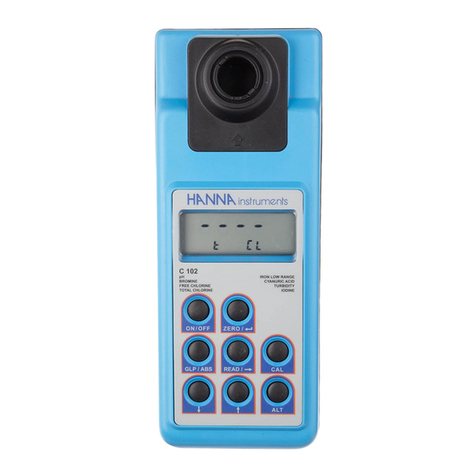
Hanna Instruments
Hanna Instruments HI 93102 instruction manual
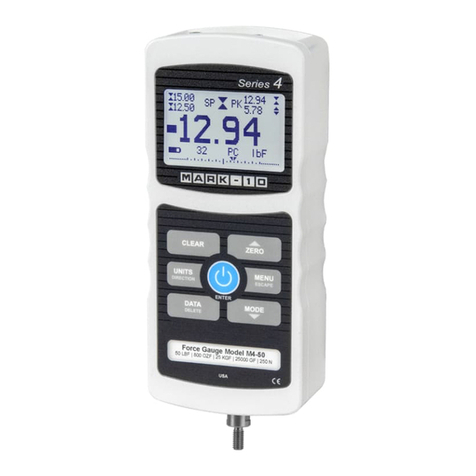
Mark-10
Mark-10 Series 4 user guide

Bushnell GOLF
Bushnell GOLF Ion Edge user manual
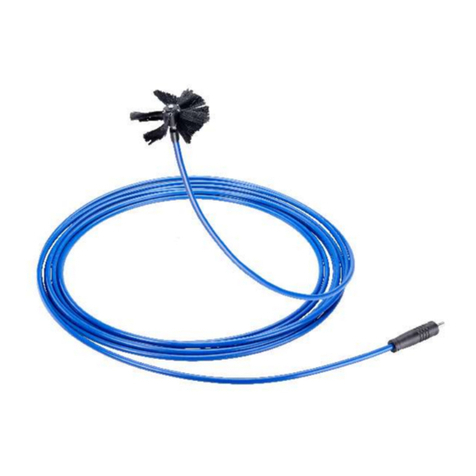
Wohler
Wohler M5 Operation manual
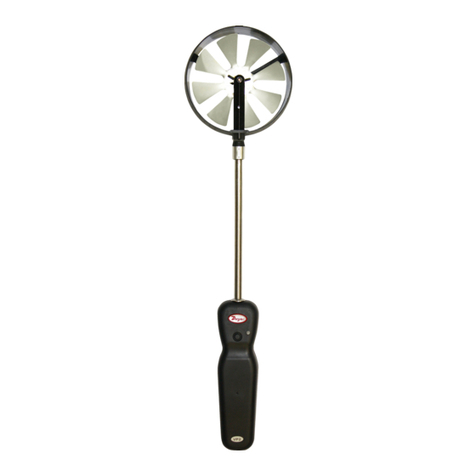
Dwyer Instruments
Dwyer Instruments VP2 Specifications-installation and operating instructions

